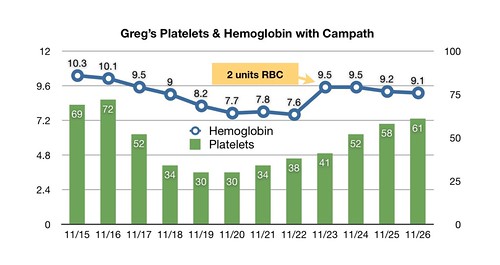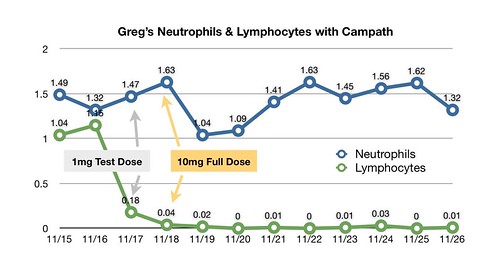Day 12, the final in-hospital day of the NIH Campath Trial, was very busy, compared to the past few days.
After packing my suitcase in the early morning, I received my last dose of Campath from 10:30 am to 12:30 pm, again without incident, aside from some drowsiness an hour into the process, as likely a side effect of the double-dose of Benadryl as of the Campath.
Then it was up to Cardio for a post-trial ECHOcardiogram and down to EKG to be outfitted with a 24-hour Holter monitor to record my heart rhythms on the way home. Back in my room, a nurse outfitted with a fetching pink mask removed all 43 centimeters of PICC Line. I was asked to lie on my back for 30 minutes and then released into the wide world with no dietary restrictions, owing to my mild (not moderate) neutropenia. (However, a nice printout called "Don't Let Your Food Make You Sick" was included in the discharge packet, along with some advice about how to respond to various levels of fever.)
Earlier in the day, Dr. Yun stopped by, most excited that my absolute reticulocytes (baby red cells) had jumped from 17 to 54, suggesting that my production of red blood cells could be improving. Dr. Tisdale was optimistic about the same result during rounds, though he cautioned we'd want to see if it it held up in subsequent results.
 Greg's Hgb & Platelets
Greg's Hgb & Platelets by
hankins.greg, on Flickr
Dr. Olnes, the Principal Investigator on the trial, also stopped by for a debriefing. He noted the reticulocyte result and the trend upwards in my platelets. He remarked on the upward trend in my neutrophil count, though he hadn't, at that point, seen that my Day 12 labs showed a steep drop back down to an ANC of 1.32. As I've noted before, neutrophils -- or, at least, my neutrophils -- seem highly variable from day to day.
 Greg's Neutros and Lymphos
Greg's Neutros and Lymphos by
hankins.greg, on Flickr
Dr. Olnes also mentioned that
Blood had just published a new MDS article by his colleague Dr. Elaine Sloand. It establishes some of the molecular mechanisms underlying the type of MDS that responds to immunosuppressive therapy. It's pretty technical stuff, but I've done my best to summarize the results in a post
here.
Daughter Jeni and I waited 30 minutes for things to settle down after the removal of my PICC Line; and, after a stop at the pharmacy to pick up a month's supply of Valtrex, we walked past the guards and out the gates of the National Institutes of Health into the next chapter of my life with MDS: waiting for the response.
The drive home took longer than I had expected. I'd forgotten that, when pulling an Airstream, 70-miles per hour on the interstate is not a good idea. Given my lack of substantial neutropenia, we even stopped off for dinner at an Olive Garden south of Richmond (It's one of the few national chains at which a vegan can assemble a reasonable meal without feeling out of place. Jeni & Billy are vegans; I'm not definitely not).
I'm grateful for all the comments and encouragement I received while in hospital from this wonderful community of teachers, fighters, and survivors. I won't be posting daily results from here on out, since I won't have daily results. (Though I will definitely be following Birgitta's advice to control my temperature morning and evening!) But I do plan to continue to add progress reports to this thread as they become available. I'm scheduled for weekly blood work at my local hematologist's office and a follow-up at NIH in mid-December.